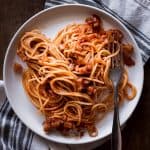Print
Chef Stefano’s Bucatini all’ Amatriciana Recipe
On the table in 30 minutes, Chef Stefano’s Bucatini all' Amatriciana recipe is an easy dinner with less than 10 ingredients. This Italian pasta favourite has a gorgeously rich tomato sauce, smoky guanciale, hint of chilli and freshly grated pecorino romano cheese.
Servings 4 people
Calories 949kcal
Cost $10
Equipment
Ingredients
- 400 g pasta penne, spaghetti or bucatini -100 g per person
- 2 cups pasta water leftover from cooking your pasta
- 400 g passata
- 200 g guanciale or sub with pancetta or bacon pieces
- 1 onion finely chopped
- ¼ cup olive oil extra virgin
- 1 small red chilli finely sliced
- ½ cup pecorino romano cheese grated
- 1 pinch rock salt for boiling pasta
Instructions
- Let's start by bringing a large saucepan of water to boil. For the best texture, use 1 litre of water per 100 g of pasta, and add in a large pinch of good quality rock salt.1 pinch rock salt
- Once the water's boiling, add your pasta and cook for a few minutes LESS than the packet directions indicate (the pasta will continue to cook when it's added into the sauce). Take out 2 cups of the pasta water to use in the sauce then drain the pasta.400 g pasta, 2 cups pasta water
- Meanwhile, heat the olive oil in a large pan over a high heat. Add the onion, chillis and guanciale/pancetta or bacon pieces, and stir fry until gorgeously fragrant.200 g guanciale, 1 onion, ¼ cup olive oil, 1 small red chilli
- The next step is to add the passata and start with 2 ladles of pasta water (not the whole 2 cups!). Stir everything through then reduce heat to low and simmer for a few minutes. Optional: If you decide the sauce is too thick, then you can add more pasta water - we recommend a half a ladle at a time.400 g passata, 2 cups pasta water
- Now for the fun part! Place the drained pasta on top of the sauce, but DON'T mix through yet. First, top the pasta with your grated pecorino romano cheese and gently mix it through the pasta (avoiding the sauce as much as possible).½ cup pecorino romano cheese
- Once the pasta is coated with that wonderfully melted cheese, you can start to slowly mix it in with the sauce. It should bind nicely to the cheese-coated pasta.
- To serve, portion out the pasta into serving bowls, leaving some of the cooked pancetta to place on the top as a garnish.
Video
Notes
- For the Roman Version - Add 2 cloves of garlic, whole and slightly crushed, then remove before serving.
For the Amatrice Version - Omit the onion, use canned peeled tomatoes instead of passata and add ¼ cup white wine after cooking the guanciale. - Pasta - This recipe suits both long pasta like spaghetti or bucatini, or you can use a short pasta such as penne or fusilloni. We use Garofalo pasta, as it’s high quality, and made in Naples, Italy.
- Make your own Pasta - Make a full night of it by making your own pasta to pop into the dish!
- Al Dente Pasta - For the perfect al dente pasta, cook the pasta for a couple minutes less than the recommendation on the packet.
- Pasta Water - Pasta water is the unsung hero of Italian pasta sauces. All that milky white starch helps give your sauce a smoother consistency and bind with your pasta.
- Passata at Room Temperature - Passata is different from other tomato based pasta sauces because it’s essentially uncooked tomato puree strained of the seeds and skin. Stefano’s number one rule when it comes to using passata is to always use it at room temperature. If you’ve got passata that’s been in the fridge, run it under warm water to bring it to room temperature. Substitute with the more traditional can of peeled tomatoes, crushed by hand, or a can of chopped tomatoes.
- Guanciale - Bucatini all’amatriciana traditionally calls for an Italian cured meat called guanciale, which is made with pork cheek / pork jowl. Guanciale can sometimes be hard to find, but thankfully it’s extremely similar to pancetta. Look for either type at your local supermarket, Italian grocery store, or even online. If you can’t find guanciale or pancetta you can easily substitute with bacon chopped into pieces.
- Onion - Use white onion, or omit for a more authentic amatriciana.
- Chilli - Use a fresh whole red chilli, or substitute with a teaspoon of chilli flakes. You can also use black pepper if you prefer.
- Cheese - Use pecorino romano cheese in the first instance, or substitute with parmesan cheese. The sharpness from the cheese really brings up the flavour to the next level.
- Olive Oil - This recipe calls for a good amount of extra virgin olive oil in the sauce, however, this is not always to everyone’s taste. Feel free to adjust the amount of olive oil used in the sauce to suit your own preference.
Nutrition
Calories: 949kcal | Carbohydrates: 88g | Protein: 25g | Fat: 56g | Saturated Fat: 19g | Cholesterol: 67mg | Sodium: 615mg | Potassium: 749mg | Fiber: 6g | Sugar: 9g | Vitamin A: 669IU | Vitamin C: 29mg | Calcium: 178mg | Iron: 3mg
